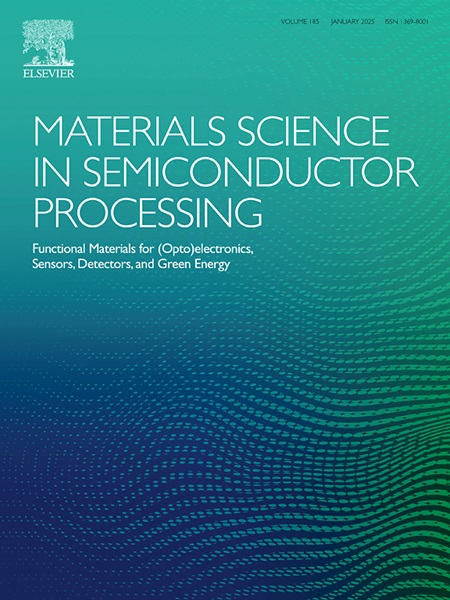Modulating localized surface plasmon resonance through metal composition and nanoparticle Shape: Implications for solar cell applications
IF 4.2
3区 工程技术
Q2 ENGINEERING, ELECTRICAL & ELECTRONIC
引用次数: 0
Abstract
Localized Surface Plasmon Resonance (LSPR) is an important optical effect that arises when conductive nanoparticles interact with incoming light. This interaction causes the conduction electrons on the surface of the nanoparticles to oscillate collectively, which in turn generates enhanced electromagnetic fields in their vicinity. In this study, we synthesized three distinct types of plasmonic nanoparticles (P-NPs): Ag sphere, Ag plate, and Au sphere. These nanoparticles exhibited unique LSPR characteristics that were influenced by their shape and composition. All synthesized P-NPs were incorporated into dye-sensitized solar cells (DSSCs) to evaluate their influence on device efficiency through LSPR characteristics. Devices utilizing Ag plates at a concentration of 0.4 wt% demonstrated optimal performance, achieving a short-circuit current density (JSC) of 18.5 mA/cm2, an open-circuit voltage (Voc) of 0.79 V, and a power conversion efficiency (PCE) of 10.2 %. In comparison, systems employing Au spheres at 0.5 wt% and Ag spheres at 0.7 wt% exhibited comparatively lower PCEs of 9.81 % and 9.1 %, respectively. Finally, Raman spectroscopy was employed to confirm the LSPR effect induced by P-NPs.
通过金属成分和纳米颗粒形状调制局部表面等离子体共振:对太阳能电池应用的影响
局部表面等离子体共振(LSPR)是导电纳米粒子与入射光相互作用时产生的一种重要的光学效应。这种相互作用导致纳米颗粒表面的传导电子集体振荡,从而在其附近产生增强的电磁场。在这项研究中,我们合成了三种不同类型的等离子体纳米粒子(P-NPs):银球、银板和金球。这些纳米颗粒表现出独特的LSPR特性,这些特性受其形状和组成的影响。将所有合成的P-NPs纳入染料敏化太阳能电池(DSSCs)中,通过LSPR特性评估其对器件效率的影响。使用浓度为0.4 wt%的银板的器件表现出最佳性能,实现了18.5 mA/cm2的短路电流密度(JSC), 0.79 V的开路电压(Voc)和10.2%的功率转换效率(PCE)。相比之下,使用重量为0.5 wt%的Au球和0.7 wt%的Ag球的体系,pce分别为9.81%和9.1%,相对较低。最后利用拉曼光谱验证了P-NPs诱导的LSPR效应。
本文章由计算机程序翻译,如有差异,请以英文原文为准。
求助全文
约1分钟内获得全文
求助全文
来源期刊

Materials Science in Semiconductor Processing
工程技术-材料科学:综合
CiteScore
8.00
自引率
4.90%
发文量
780
审稿时长
42 days
期刊介绍:
Materials Science in Semiconductor Processing provides a unique forum for the discussion of novel processing, applications and theoretical studies of functional materials and devices for (opto)electronics, sensors, detectors, biotechnology and green energy.
Each issue will aim to provide a snapshot of current insights, new achievements, breakthroughs and future trends in such diverse fields as microelectronics, energy conversion and storage, communications, biotechnology, (photo)catalysis, nano- and thin-film technology, hybrid and composite materials, chemical processing, vapor-phase deposition, device fabrication, and modelling, which are the backbone of advanced semiconductor processing and applications.
Coverage will include: advanced lithography for submicron devices; etching and related topics; ion implantation; damage evolution and related issues; plasma and thermal CVD; rapid thermal processing; advanced metallization and interconnect schemes; thin dielectric layers, oxidation; sol-gel processing; chemical bath and (electro)chemical deposition; compound semiconductor processing; new non-oxide materials and their applications; (macro)molecular and hybrid materials; molecular dynamics, ab-initio methods, Monte Carlo, etc.; new materials and processes for discrete and integrated circuits; magnetic materials and spintronics; heterostructures and quantum devices; engineering of the electrical and optical properties of semiconductors; crystal growth mechanisms; reliability, defect density, intrinsic impurities and defects.
 求助内容:
求助内容: 应助结果提醒方式:
应助结果提醒方式:


